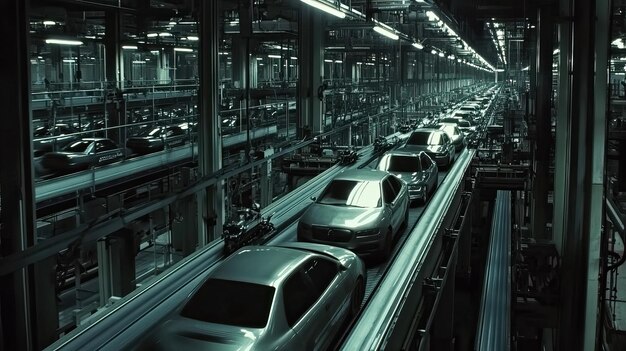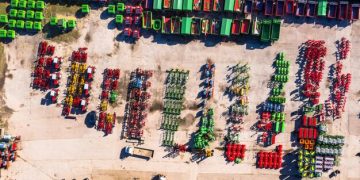Mexico’s Automotive Industry: US Trade Agreement Impacts on Production

The evolving landscape of US trade agreements significantly shapes Mexico’s automotive industry, influencing production strategies, supply chains, and export dynamics.
The intricate relationship between the United States and Mexico, particularly concerning trade agreements, has long been a cornerstone of North American economic stability. Within this dynamic, the future of Mexico’s Automotive Industry: How Will New US Trade Agreements Affect Production? presents a complex yet fascinating puzzle. As policies shift and global supply chains recalibrate, understanding these potential impacts becomes crucial for stakeholders on both sides of the border.
The USMCA Framework and Its Predecessors
The United States-Mexico-Canada Agreement (USMCA), which came into effect in July 2020, replaced the North American Free Trade Agreement (NAFTA). This transition marked a significant shift in trade policy, particularly for the automotive sector. USMCA introduced stricter rules of origin, aiming to bring more manufacturing back to North America and reduce reliance on components from outside the region.
Under NAFTA, the automotive industry in Mexico thrived due to lower labor costs and less stringent rules of origin, allowing for a more globalized supply chain. Many international automakers established significant production facilities in Mexico, leveraging its strategic geographic position and trade access to the US market. The integration of these supply chains became deeply entrenched over decades.
Evolution of Rules of Origin (ROO)
The shift from NAFTA to USMCA brought about substantial changes in the rules of origin for vehicles and automotive parts. Under USMCA, the regional value content (RVC) requirement for passenger vehicles and light trucks increased from 62.5% under NAFTA to 75%. This means a larger percentage of a vehicle’s value must originate from North America to qualify for duty-free treatment.
Beyond the RVC, USMCA also introduced a new Labor Value Content (LVC) requirement. This mandates that 40-45% of a vehicle’s value must be produced by workers earning at least $16 per hour. This provision directly impacts Mexico, where average automotive wages are significantly lower than in the US and Canada. Automakers operating in Mexico face the challenge of adapting their labor practices or adjusting their supply chains to meet this new criterion.
- Increased RVC to 75% for vehicles.
- New Labor Value Content (LVC) requirement of 40-45%.
- Expanded list of core parts subject to ROO.
- Stricter traceability for parts origin.
These new rules have placed a considerable burden on automakers and their suppliers to re-evaluate their production strategies. Companies must decide whether to invest in expanding North American supply chains, absorb potential tariffs, or explore alternative markets. For Mexico’s automotive sector, this translates into pressure to increase local content and potentially raise wages, which could alter its competitive advantage.
The intricate details of USMCA’s rules of origin extend beyond just the final vehicle assembly. Specific core parts, such as engines, transmissions, and axles, have their own higher RVC requirements. This granular approach necessitates a deep dive into the origin of every component, making compliance a complex undertaking. The long-term implications for Mexico’s role as an automotive manufacturing hub are profound, as companies weigh the costs and benefits of compliance.
Companies that fail to meet these stringent new requirements risk paying tariffs when exporting vehicles to the United States. This potential cost increase could diminish Mexico’s attractiveness as a production base, prompting some automakers to reconsider their investment strategies within the country. The transition period for full USMCA implementation, which includes phased-in compliance for some rules, has given companies time to adjust, but the fundamental challenges remain.
Shifting Production Strategies and Investment
The advent of new US trade agreements, particularly USMCA, has undeniably reshaped the strategic planning for automotive manufacturers with operations in Mexico. Companies are no longer operating under the more lenient NAFTA rules, necessitating a re-evaluation of where and how they produce. This re-evaluation often involves complex cost-benefit analyses, taking into account labor costs, logistics, and compliance with the updated rules of origin and labor value content requirements.
Many automakers are now facing a crucial decision: either invest in reshoring some production to the US or Canada, thus increasing North American content, or significantly adjust their operations in Mexico to meet the new criteria. This might involve sourcing more components from within North America or implementing strategies to qualify for the LVC credits.
Nearshoring and Reshoring Dynamics
The concept of “nearshoring” – bringing supply chains closer to the final market – has gained significant traction. For the North American automotive industry, this means an increased focus on manufacturing within the USMCA trade bloc. While some production might move from Mexico to the US or Canada (reshoring), Mexico could also benefit from nearshoring by attracting investments from companies currently sourcing from Asia or Europe, as long as they can meet the USMCA requirements.

The primary driver for nearshoring and reshoring is often the desire to reduce supply chain vulnerabilities, which were starkly exposed during the COVID-19 pandemic and subsequent global disruptions. Geopolitical tensions and the desire for greater self-sufficiency in critical industries also contribute to this trend. For Mexico, the challenge lies in demonstrating its continued competitiveness and its ability to adapt to the new regulatory environment.
Automakers are exploring various approaches to navigate this new landscape. Some are investing in new facilities or expanding existing ones in the US to increase their RVC, while others are working closely with their Mexican suppliers to help them achieve compliance. This collaboration often involves sharing expertise in manufacturing processes, quality control, and even supporting local workforce development initiatives aimed at skill enhancement and wage adjustments.
- Increased investment in North American component manufacturing.
- Strategic assessment of facility locations and expansion plans.
- Focus on localizing supply chains for critical automotive parts.
- Potential shifts in capital expenditure away from certain regions.
The dynamic interplay between economic incentives and regulatory compliance dictates future investment patterns. While the LVC requirement might initially appear to disadvantage Mexico, proactive measures by the Mexican government and local industry to improve labor conditions and productivity could mitigate some of these negative impacts. Furthermore, Mexico’s established industrial infrastructure and skilled workforce remain attractive assets.
Ultimately, the decisions made by individual automotive companies will accumulate to define the future shape of Mexico’s automotive industry. While some production lines might indeed shift, many companies with long-standing operations in Mexico are likely to seek solutions that allow them to maintain their presence, given the significant investments already made and the established logistical networks. This often involves a multi-faceted approach, combining internal adjustments with strategic partnerships.
Impacts on Labor and Supply Chains
The USMCA trade agreement, with its stringent labor value content (LVC) requirement, exerts significant pressure on the labor landscape of Mexico’s automotive industry. This provision mandates that a certain percentage of a vehicle’s value must come from production by workers earning at least $16 per hour. For Mexican factories, where wages are traditionally lower, this presents a substantial compliance challenge and a potential catalyst for change.
The goal of the LVC is ostensibly to prevent wage arbitrage and encourage higher-wage manufacturing in North America. For Mexico, this could lead to upward pressure on wages in the automotive sector, aiming to align them more closely with US and Canadian standards. While beneficial for workers, this might erode some of Mexico’s cost advantages, potentially influencing where future investments are made.
Supply Chain Reconfiguration
Beyond labor, the new rules of origin necessitate a profound reconfiguration of automotive supply chains. Companies are now obligated to trace the origin of every component with greater precision to ensure they meet the 75% regional value content threshold. This increased scrutiny means less reliance on parts from outside North America, particularly from Asian suppliers that were common under NAFTA.
Automakers are now actively seeking out and developing suppliers within the USMCA region, including Mexico, who can provide compliant parts. This emphasis on regional sourcing could create new opportunities for Mexican companies capable of producing high-quality components that meet the strict origin requirements. However, it also demands significant investment in technology, quality control, and capacity building from these suppliers to scale up and meet demand.
- Increased demand for North American-sourced components.
- Pressure on Mexican suppliers to innovate and meet quality standards.
- Potential for new manufacturing opportunities within Mexico.
- Challenges in integrating new suppliers into existing complex chains.
The complexity of retooling supply chains is immense. It involves not just finding new suppliers but also qualifying them, integrating their processes, and ensuring reliability. This is not an overnight process and requires substantial capital expenditure and time. Companies are engaging in long-term strategic planning to slowly transition their sourcing arrangements, often in phases.
The impact on smaller Mexican suppliers could be mixed. Those that can adapt quickly and demonstrate a strong capacity for meeting the new requirements may thrive, becoming integral to larger North American supply chains. However, those unable to make the necessary investments or meet quality and transparency standards might struggle to compete. This could lead to a consolidation of suppliers or a shift towards larger, more established players.
The dual pressures of labor compliance and supply chain restructuring mean Mexico’s automotive sector is in a period of intense transformation. While the path ahead is challenging, it also presents an opportunity for the industry to mature, embrace higher-value production, and strengthen its position within a more integrated North American sphere. The long-term success will hinge on the industry’s ability to adapt and innovate in response to these new trade realities.
Rising Trends: Electrification and Automation
The global automotive industry is undergoing a profound transformation driven by electrification and increasing automation, trends that intersect significantly with the evolving trade landscape. For Mexico’s automotive industry, these trends represent both immense opportunities and significant challenges, independent of, yet influenced by, new US trade agreements.
The global push towards electric vehicles (EVs) means a fundamental shift in vehicle architecture and the components required. Traditional internal combustion engine (ICE) parts like exhaust systems and fuel pumps are replaced by batteries, electric motors, and advanced power electronics. This requires a complete retooling of manufacturing facilities and a significant investment in new machinery, skills, and supply chains.
Navigating the EV Transition
For Mexico, the transition to EV manufacturing is crucial for maintaining its competitiveness. Automakers with robust EV strategies are increasingly looking to establish or convert production lines for electric vehicles in Mexico. This could potentially mitigate some of the challenges posed by USMCA, as EV components often have different sourcing profiles and may present new opportunities for regional content creation. However, battery production, a critical component of EVs, is still largely concentrated in Asia, presenting a unique challenge for meeting North American content rules.

Automation, meanwhile, is becoming a ubiquitous feature in automotive manufacturing worldwide. Robotics, artificial intelligence, and advanced manufacturing techniques are employed to increase efficiency, precision, and safety on the factory floor. While automation can reduce labor costs, it also demands a highly skilled workforce capable of operating and maintaining these complex systems.
- Investment in EV battery manufacturing and assembly.
- Retooling existing facilities for electric vehicle production.
- Adoption of advanced robotics and AI in manufacturing.
- Reskilling and upskilling the workforce for new technologies.
For Mexico, embracing automation is essential to remain a competitive production hub. Companies establishing automated lines in Mexico can benefit from efficient production, but it also necessitates a pipeline of engineers and technicians trained in advanced manufacturing. The Mexican government and educational institutions are increasingly focusing on developing these skills to meet the industry’s evolving demands, understanding that technological advancement is key to long-term growth.
The intersection of trade agreements and technological trends creates a complex scenario. While stricter North American content rules might encourage domestic production, the global nature of EV supply chains, particularly for critical components like batteries and semiconductors, means that full regional independence is challenging. Mexico’s ability to attract investments in these new technologies will be pivotal for its future role in the automotive industry.
The future success of Mexico’s automotive sector will heavily depend on its proactive adaptation to these trends. Investing in infrastructure for EV charging, incentivizing battery and component manufacturing, and fostering a highly skilled workforce are all critical steps. By aligning its capabilities with the demands of electrification and automation, Mexico can solidify its position as a strategic manufacturing partner in the evolving global automotive landscape.
Future Outlook and Strategic Adaptations
The landscape for Mexico’s automotive industry, shaped by new US trade agreements, is one of continuous evolution. The immediate future will likely involve a period of adjustment for many firms, as they fully implement changes required by the USMCA. This adaptation is not merely about compliance but also about finding new avenues for growth and maintaining competitive advantage within North America.
For Mexico, a key strategy involves leveraging its existing manufacturing prowess and strategic location to attract continued foreign direct investment (FDI). This means emphasizing factors beyond just labor cost, such as a skilled workforce, competitive logistics, and a developing ecosystem of suppliers that can meet higher regional content requirements.
Government Policies and Industry Response
The Mexican government plays a vital role in facilitating this transition. Policies aimed at strengthening local supply chains, providing incentives for high-tech manufacturing, and investing in workforce development will be crucial. Initiatives that promote the development of small and medium-sized enterprises (SMEs) to become part of the automotive supply chain, particularly for newer technologies like EV components, could also yield significant benefits.
Industry associations and individual companies are responding by increasing collaboration. Automakers are working more closely with their direct suppliers to ensure compliance and help them overcome technical and financial hurdles. This collaborative approach is vital for strengthening the regional supply chain as a whole, ensuring that components produced in Mexico contribute effectively to the final product’s North American content. This interconnectedness fosters a stronger, more resilient automotive ecosystem.
The long-term outlook suggests a more integrated North American automotive market. While some initial shifts in production might occur, Mexico’s fundamental advantages are likely to ensure its continued prominence. The country has a robust manufacturing base, years of accumulated expertise, and established logistical networks. These factors, combined with a proactive approach to adapting to new trade rules and technological shifts, position Mexico for continued relevance.
- Proactive government policies to attract FDI.
- Focus on developing high-value manufacturing capabilities.
- Increased collaboration between automakers and Mexican suppliers.
- Emphasis on workforce training for advanced manufacturing.
One potential adaptation involves diversifying export markets. While the US undoubtedly remains Mexico’s primary automotive export destination, exploring opportunities in other Latin American countries or even Europe could provide resilience against future unilateral policy changes from the US. This kind of market diversification would require strategic investments in logistics and trade agreements with new partners.
Ultimately, the success of Mexico’s automotive industry will hinge on its agility. The ability to quickly respond to changing trade environments, embrace new technologies, and continuously enhance its value proposition will determine how well it navigates the complexities of the global automotive landscape. The path is not without challenges, but the foundational strengths of the Mexican automotive sector provide a solid basis for future growth and adaptation.
Resilience and Adaptation in Action
The Mexican automotive industry has demonstrated remarkable resilience and adaptability throughout its history, navigating various economic fluctuations and policy changes. The current challenges posed by new US trade agreements are no exception. Rather than being solely a recipient of foreign investment, the industry is actively engaged in strategic adaptations to solidify its position.
A significant aspect of this adaptation is the continuous investment in upgrading manufacturing processes and technologies. Many plants in Mexico are among the most advanced globally, incorporating cutting-edge robotics and automation. This level of technological sophistication enables higher precision, efficiency, and quality, making Mexican production competitive even with rising labor costs or stricter content rules.
Case Studies in Collaboration
Several global automakers have highlighted their long-term commitment to Mexico, signaling confidence in the industry’s ability to meet new demands. Anecdotal evidence suggests that companies are investing in training programs for their Mexican workforce, not only to comply with labor value content requirements but also to prepare for the increased sophistication of EV manufacturing. This involves partnerships with local technical schools and universities to develop specialized curricula.
Furthermore, discussions with automotive suppliers indicate a push towards localizing more complex components within Mexico. This isn’t just about simple assembly but about manufacturing high-value parts, which contributes more significantly to regional content. This requires an upgrade in the capabilities of Mexican suppliers, often through technology transfer and joint ventures with international partners.
The capacity for innovation within Mexico’s automotive clusters is also growing. Research and development centers, often established by major automotive players, are contributing to vehicle design, engineering, and the development of new manufacturing techniques. This intellectual capital is vital for moving up the value chain from basic assembly to more complex, high-technology production.
- Strategic investments in advanced manufacturing technologies.
- Enhanced training and skill development programs for the workforce.
- Increased localization of complex, high-value component manufacturing.
- Growth of R&D and innovation centers within automotive clusters.
The government’s role in facilitating this adaptation cannot be understated. Efforts to streamline customs procedures, invest in infrastructure (like roads and ports), and ensure a stable regulatory environment provide a much-needed foundation for sustained growth. These supportive measures help reinforce Mexico’s attractiveness as a manufacturing destination, even under tightened trade conditions.
The collective efforts of government, industry, and academia in Mexico point towards a robust effort to not just react to trade agreement changes but to proactively shape the industry’s future. By focusing on higher value-added activities, technological advancement, and a skilled workforce, Mexico aims to remain a vital cog in the North American, and indeed global, automotive production machine. The story of its automotive sector is a testament to its enduring capacity for resilience and strategic adaptation in the face of evolving global dynamics.
| Key Aspect | Brief Description |
|---|---|
| 📊 USMCA Rules of Origin | Increased regional value content (75%) and new labor value content ($16/hr) requirements are reshaping supply chains. |
| ⚙️ Production Shifts | Automakers are re-evaluating production, potentially nearshoring parts to North America, impacting Mexican facilities. |
| 💡 Electrification & Automation | Mexico must adapt to EV production and advanced automation to remain competitive, requiring significant investment. |
| 🤝 Resilience & Adaptation | Industry and government are collaborating to enhance skills, tech, and local sourcing to navigate new trade realities. |
Frequently Asked Questions
▼
The USMCA significantly increased the regional value content (RVC) requirement for vehicles to 75% and introduced a labor value content (LVC) rule, mandating that 40-45% of a vehicle’s value come from workers earning at least $16 per hour. These changes push for more North American production and higher wages.
▼
The LVC is expected to put upward pressure on wages in Mexico’s automotive sector. Companies must either raise wages for a portion of their workforce or find ways to qualify for the LVC through other means, potentially reducing Mexico’s traditional cost advantage. However, this could improve living standards for some workers.
▼
While some production shifts may occur, the overall impact on Mexican automotive jobs is complex. Mexico’s established infrastructure and skilled workforce remain attractive. The industry is adapting by investing in technology and higher-value production, aiming to retain and potentially create new jobs in advanced manufacturing and EV production.
▼
Mexican suppliers are under pressure to increase their North American content and improve quality. This involves significant investment in technology and capacity. Many are partnering with international firms or receiving support from major automakers to meet the stringent new rules of origin, fostering a more integrated regional supply chain.
▼
The global shift to EVs and automation adds another layer of complexity and opportunity. Mexico must invest heavily in EV battery and component manufacturing and advanced automation to remain competitive. This could create new niches and mitigate some USMCA challenges if it allows for the creation of new high-value regional content.
Conclusion
The future of Mexico’s automotive industry is inextricably linked to the evolving landscape of US trade agreements. While the USMCA has introduced more rigorous requirements, particularly concerning regional content and labor value, the industry is demonstrating significant resilience and a proactive approach to adaptation. By investing in advanced manufacturing, fostering a highly skilled workforce, and strategically reconfiguring supply chains, Mexico is poised to maintain its crucial role in the North American automotive ecosystem. Challenges persist, but the industry’s capacity for innovation and strategic foresight suggests a continued, albeit transformed, prominence in global vehicle production.





